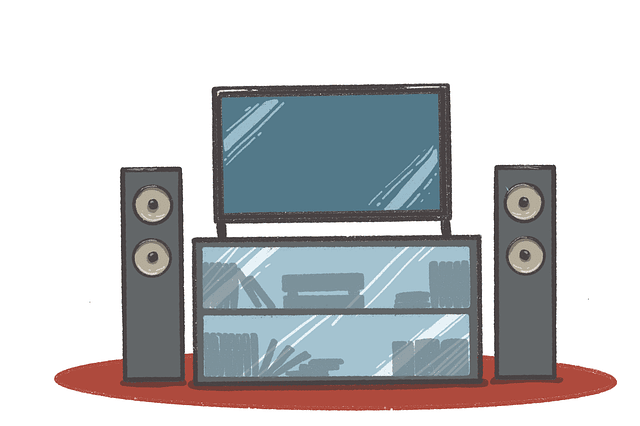7.1 vs. 5.1 Surround Sound System: You have been saving for a long time and are finally getting your hands on the home theatre device of your dreams. Your dreams, on the other hand, have been a little hazy, leaving you unsure about what kind of sound system to get. You can’t pick between 5.1 and 7.1 surround sound, for example.
The 5.1 surround sound system includes a subwoofer, front left, front right, front middle, surround right and surround left speakers, and a front left, front right, and front center mic. A 7.1 surround sound system is similar to a 5.1 surround sound system but with the inclusion of a range of rear surround speakers.
So, which is the better option? Unfortunately, the short answer is “it depends.” If you can use a 5.1 or 7.1 method is determined by a variety of factors. Space will determine the others you’re working in, and others will be determined by personal choice.
The size of your room, the furniture you have in it, and your listening position will influence which sound system is best for you. In this article, we’ll look at the differences between 5.1 and 7.1 surround sound, as well as the factors that influence whether you should choose a 5.1 or 7.1 system.
What Is the Difference Between Surround Sound Systems 5.1 and 7.1?
Simply put, a 5.1 surround sound system differs from a 7.1 surround sound system by two speakers. Five speakers and one subwoofer make up a 5.1 system, while seven speakers and one subwoofer make up a 7.1 system.
A 7.1 surround sound system expands on the 5.1 system by adding two more surround sound speakers to give the sound more depth. It can be a fantastic listening experience in the right setting. A 7.1 device will sound muddled if it’s set up in the wrong room or incorrectly.
Three front-of-the-room speakers–right, left, and center–and two surround sound speakers on each side of the listening area are the most common configuration for a 5.1 device. By installing two additional surround sound speakers behind the listening area, a 7.1 device builds on this.
Read: IPX7 vs IP67: Which Is Better?
Pros and Cons of 5.1 Surround Sound Systems
A 5.1 sound system has several benefits and drawbacks. Despite its smaller size than a 7.1 system, a 5.1 system could be more appropriate for your home theatre.
On a superficial level, 5.1 systems are more popular than 7.1 systems, so troubleshooting instructions are easier to find online. Aside from providing a larger online group, 5.1 systems are frequently packaged as the home theatre in a box system set up straight out of the box. If you want to link your system with wires, a 5.1 system would have two fewer wires to cover. A 5.1 sound system is adequate for most rooms.
A 5.1 sound system, on the other hand, may not be enough for larger rooms. Surround sound may not feel as enveloping in large rooms as it does in small rooms if there is a lot of space behind your listening area. Some media comes pre-configured for 7.1 sound, which a 5.1 device would not produce as clearly or efficiently.
A 5.1 system would suffice for most applications, but a few drawbacks could make upgrading to a 7.1 system more appealing.
Pros and Cons of 7.1 Surround Sound Systems
A 7.1 sound system has its own set of benefits and drawbacks. A 7.1 device, despite the added power of two additional surround speakers, can detract from your listening experience.
For larger rooms where sound can get lost in the space, a 7.1 system is a great option. It gives you a more immersive surround sound listening experience. On a 7.1 system, theater-quality media can come out more clearly than on a 5.1 system.
A 7.1 method, however, has several drawbacks. The additional surrounding sound speakers in smaller rooms can cause the surrounding sound channels to take precedence over the front channels. The dialogue and front-side sound effects would be difficult to hear as a result.
Furthermore, only a few 7.1 systems are available as a complete package, necessitating individual components’ purchase. As a result, finding an online community to help troubleshoot your device is challenging since the components would be special to your configuration.
For larger spaces, a 7.1 sound system makes sense and adds dimension to your sound. They are, however, more costly and more difficult to set up and troubleshoot at the same time. In the end, the decision between a 5.1 and 7.1 sound system would be based on your specific needs.
Read: VGA vs HDMI: Which One is Better?
The 5.1 and 7.1 Surround Sound Layout
The difference between the 5.1 surround sound system and the 7.1 surround sound system, as previously stated, is two surround speakers. These extra surround speakers add dimension to the sound, allowing wide rooms to be filled with theater-quality sound.
The setup of a 5.1 device is fairly common. A middle speaker is located under your television or projector, and two front speakers are located on each side of the television. Last but not least, there are two surround speakers on each side of the listening room.
A 7.1 device incorporates two additional speakers but is otherwise identical. The five speakers that the machine shares with a 5.1 system are configured in the same way. The additional surrounding speakers are angled differently from the first set of surround speakers to go behind the listening area.
These speakers are often suspended from the ceiling. Aside from the fascinating sound experience, ceiling mounting has the benefit of freeing up space behind the listening area for walking.
What’s the Best Option for Your Room?
Several factors will influence whether a 5.1 or 7.1 sound system is suitable for your room. Simply because you want massive, theater-quality sound from a 7.1 device doesn’t mean you’ll be able to get it in any room. A room’s three main characteristics will decide the type of sound system that is appropriate for it.
Room Size: More speakers are used to fill larger spaces. Large numbers of speakers in small rooms can produce a muddy mix of sounds that sound louder than they are. In general, if your space is less than 350 square feet, you can avoid 7.1 systems.
The main difference between 5.1 and 7.1 systems is that the larger system places speakers behind the audience, providing a true surround sound experience. If you do not have a lot of room behind the listening area, it’s not a good idea to install speakers back there.
Hard surfaces, such as tables, chairs, cabinets, and wood or tile flooring, reflect sound, reducing additional speakers’ impact. Soft surfaces, like bookshelves, couches, and carpeting, help reduce sound reflection and hold sounds in the space’s intended areas.
Read: What is an HDMI Splitter and How Does it Work?
Your Budget and the Features
When choosing your perfect sound system, there are a few other things to keep in mind. The majority of these decisions will come down to balancing your budget against the benefits of a better setup.
A 7.1 system would, on average, cost more than a 5.1 system. It has more components and can produce a more immersive audio experience. However, several variables will influence the cost of your device.
Receiver: You’ll need a receiver to transform line-level signals from your TV into speaker-level signals for your speakers to operate your sound system. Many 5.1 systems have a receiver, but only a few 7.1 systems are sold as a complete kit. You can still start with a 5.1 system and upgrade to a 7.1 receiver and two additional speakers later, but this is not as desirable as having a coherent 7.1 speaker package.
Wires: Another thing to think about is how you’re going to connect your sound system. Most systems have wireless capabilities, making it easier to place speakers around the room. The comfort comes at the expense of sound quality. The efficiency of directly wired signals will still be superior to that of a wireless link. Finally, you’ll have to consider if the tangle of wires you’ll almost certainly have to buy separately is worth it.
Calibration: Many devices on the market come with their built-in calibration. These systems improve your room’s sound quality by transmitting test tones from each speaker to a microphone placed in the main listening area. These systems are more costly, and 7.1 systems are more popular.
Surround Sound System Price Differences Between 5.1 and 7.1
Price is one of the determining factors on whether to purchase a 5.1 or 7.1 device. If you’re on a budget, a 5.1 surround sound kit can be had for a very reasonable price.
You get what you settle for, so these systems will not be adequate for your requirements. The cost of a top-of-the-line 5.1 sound system from a top-of-the-line brand like Klipsch will exceed $6,000. This device can provide high-definition, theater-quality audio and will include the receiver.
If you want to go with a 7.1 surround sound system, you should budget at least $500 for a good one. It would not result in a successful method. You should expect to pay over $1,000 and up to $13,000 for a decent 7.1 surround sound system with a receiver (although you don’t need a receiver, as you’d know if you’ve read our guide).
There are more in-wall or in-ceiling speaker systems to choose from when upgrading from a 5.1 to a 7.1 surround sound system. While these may seem to be more aesthetically pleasing, they would almost certainly necessitate a professional’s services to mount. Another disadvantage is that changing systems necessitates removing speakers from the wall/ceiling and patching the void.
So, what’s the final word?
It can be intimidating to build the home theatre of your dreams, but it doesn’t have to be. Make a list of must-have features and a list of features that would be good to have to make your search easier. It’s also a good idea to set a budget before you start looking around.
The most important thing is, to be honest with yourself about your requirements. A 7.1 surround sound system can appear to be a cool status symbol, but the sound will be ruined if you put it in the wrong room. To select the right framework for you, bear in mind the characteristics of the room you’re working with. You’ll be well on your way to building your ideal home theatre experience if you follow these guidelines.
You might also like
How To Reset the Bluetooth Speaker?







